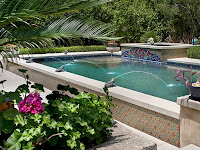Which Taylor Test Kit is Best?
I have been using the Taylor Test kits almost from day one when I started pool service back in the late 1980s and early '90s. One thing that sets Taylor apart from many other kits is the number of test factors their K-2000 kits can perform. You can do Free Chlorine & Combined Chlorine, Total Alkalinity, pH with acid demand and base demand, Calcium Hardness, and Cyanuric Acid.
As in the podcast, I suggest one of these three test kits for professional and homeowner use (you can also purchase the version in Spanish and one that does salt or salinity level testing):
K-2005* (Spanish : K-2005S*)
Complete-high (uses DPD): chlorine 1–10 ppm; bromine 2–20
ppm; pH 7.0–8.0; acid & base demand; total alkalinity;
calcium hardness; cyanuric acid; .75 oz. bottles
K-2005-SALT*
Same tests as K-2005, plus a test for sodium chloride.
Available in a case pack of six (K-2005-SALT-6)
K-2006* (Spanish : K-2006S*)
Complete-high (uses FAS-DPD): chlorine 1 drop = 0.2 or 0.5
ppm; pH 7.0–8.0; acid & base demand; total alkalinity;
calcium hardness; cyanuric acid; .75 oz. bottles
Available in a case pack of six (K-2006-6)
K-2006-SALT*
Same tests as K-2006, plus a test for sodium chloride.
Available in a case pack of six (K-2006-SALT-6)
K-1005
9-WAY (DPD)
Free & Total Chlorine .5–5 ppm
Total Bromine 1–10 ppm
pH 6.8–8.2 (with acid & base demand)
Total Alkalinity 1 drop = 10 ppm
Calcium Hardness 1 drop = 10 ppm
Cyanuric Acid 30–100 ppm
(includes I Never Liked Chemistry
booklet)
Recently, Taylor went through the NSF certification process. This involved an extensive plant inspection as well as thorough laboratory testing of test kit procedures.
19 Taylor test kits were granted NSF certification and are listed under NSF/ANSI 50 Equipment for Swimming Pools, Spas, Hot Tubs, and Other Recreational Water Facilities.
NSF International has been monitoring the safety of pool and spa industry products since the 1960s. They evaluate everything from test kits to pool alarms to ensure they meet strict safety standards. They also review product labeling and literature for truth and accuracy. Every product labeled with the NSF certification has met the American National Standards for design, construction, and/or performance.
This certification is not a one-time check, NSF International conducts “annual audits at each authorized production facility and regular re-testing of certified products to confirm that they continue to comply with all requirements of certification.”[1]
This means that 19 of their test kits can be used in Commercial applications like HOA complexes, motels, hotels, apartment complexes, and other public pools inspected by your local health department. NSF certification is a big deal and you can rest assured the test results by an NSF certified Taylor test kit will hold up against the health department testing.
The main difference is that the K-2006 kit features FASDPD drop tests, which measure free and combined chlorine directly as low as 0.2 ppm and as high as 20 ppm. The reading is made by noting a distinct change in the water sample from vibrant pink to colorless. The K-2005 will only read chlorine p to 10 ppm but is much easier to use in many cases over the FASDPD which uses a powder instead of a dye-based reagent.
Here are some basic tips:
Makes sure your reagents are not expired. They do not last forever and you should replace them every season if you don't use them all up during the year. The refills are affordable and will ensure accurate test results.
Try to take the water sample from the middle of the pool about elbow deep. Make sure you fill the tubes to the exact mark and do the reagent drop test right away.
Make sure the tubes are clean especially if you service pools for a living, you don't want the last test results to interfere with your current one.
With the swirl, tests try to get a good wrist movement to mix the reagent up properly. If you struggle with this check out this helpful product that does the swirling for you:
Taylor SpeedStir 9265 Magnetic Stirrer: https://youtu.be/IRofeofrlCs
Keep the tubes at eye level and look directly at the color and not down into it. I prefer doing the reading outside in natural light. Remove your sunglasses for a more accurate color match.
If you follow these steps you will get a very accurate reading when you do your water testing. To learn more about the lineup of Taylor Technologies testing products you can visit their website here:
Visit my Website: http://www.swimmingpoollearning.com/

Comments
Post a Comment